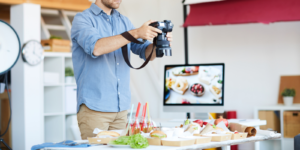
theCloud
Elevate Your Restaurant's Appeal: 8 Food Photography Tips to Know

In our digitally driven world, where every restaurant seeks to claim its space and draw attention, the significance of an impactful food photograph cannot be overstated. Going beyond the mere act of snapping a picture, top-tier food photography provides a platform to effectively and professionally showcase the depth and breadth of a restaurant’s culinary artistry. With millions of images vying for attention across various digital platforms every day, there’s an urgent need for your restaurant’s visuals to not only stand out but also communicate your brand’s essence in a glance. With this context in mind, let’s delve into comprehensive insights and practices that will aid in enhancing your restaurant’s digital presence.
The Art of Plating
The art of plating stands at the intersection of culinary skills and visual aesthetics. A well-presented dish speaks of attention to detail, creativity, and dedication to delivering a memorable experience to diners. It’s not just about positioning the primary elements; the plate should be viewed as a stage where each ingredient, garnish, and drizzle plays its part in creating a visual masterpiece. This harmony of colors, textures, and placement transforms a dish from mere food to a work of art. Mastering this art is essential as it serves as the foundation for capturing a photograph that draws viewers in, evoking curiosity and desire.
Natural Lighting is Your Best Friend
Lighting plays a pivotal role in photography, and when it comes to food, natural light reigns supreme. The soft, diffused illumination that natural light offers can bring out the true colors and textures of a dish, lending it an authenticity that’s hard to replicate with artificial sources. A simple placement near a window with the ambient light casting gentle shadows can elevate the visual appeal of a dish multifold. This subtle yet effective approach amplifies the dish’s inherent beauty, making it more relatable and appetizing to the audience.
The Right Equipment Matters
In the intricate realm of food photography, having the appropriate equipment is indispensable. While creativity and an artistic eye are crucial, they need to be complemented with tools that can capture your vision accurately. From DSLRs to mirrorless cameras, there are several options that offer remarkable clarity and detail. But beyond just the camera, additional equipment like tripods plays a significant role. A tripod provides stability, ensuring that each shot is clear, sharp, and free from any unintended movement, thus guaranteeing consistently professional results.
Angles and Perspectives
Every dish, with its unique composition and elements, often shines differently from various angles. Some dishes are best captured in an overhead shot, showcasing their layout, while others require a side angle to highlight layers or height. The key lies in experimentation. By adjusting the camera’s position and perspective, one can find that optimal angle that makes the dish pop, highlighting its most enticing features and ensuring it looks as delicious as it tastes.
Depth and Background
Creating a visual depth in food photography ensures that the dish remains the focal point, drawing the viewer’s gaze and making the food truly stand out. This can be achieved by playing with depth of field, allowing for a sharp focus on the dish while subtly blurring the background. Speaking of the background, it plays a crucial role too. Whether you opt for the rustic textures of worn wood or the sleek finish of marble, it should be selected to complement the dish, adding to the narrative without overpowering it.
Editing to Enhance, Not Overpower
In the post-shooting phase, editing is a powerful tool to refine and perfect the captured images. However, restraint is crucial. The objective is to enhance the natural qualities of the photograph, adjusting lighting or color balance to bring out the best in the image. Overediting, on the other hand, can strip away the authenticity of the dish, making it look artificial. The balance is essential to ensure the photograph remains genuine, inviting, and mouthwatering.
Storytelling Through Props
Props, when used judiciously, can amplify the story that a dish tells. From the ingredients that hint at the flavors in the dish to utensils that add a touch of authenticity or nostalgia, props should be selected with care. Their purpose is to complement, to add layers to the visual story without detracting from the main hero – the dish. Strategic placement can lend context, evoke emotions, or simply add a touch of aesthetics to the frame.
Choosing the Right Photographer
The decision to select a photographer is a significant one. It’s about choosing someone who can translate the restaurant’s culinary vision into visual stories that resonate. A photographer’s portfolio can offer insights into their style and proficiency, but understanding of lighting, composition, and, importantly, food is paramount. The right photographer doesn’t just capture images; they encapsulate the essence, flavors, and ethos of the dish in each frame.
Wrapping it up
In the fiercely competitive restaurant industry, top-notch food photography is a critical differentiator. While the taste, aroma, and ambiance play their roles in a diner’s experience, visuals bridge the gap between the restaurant and potential patrons in the digital world. Investing time and effort in crafting and capturing these visuals ensures that every image serves not just as a visual treat but as an impactful marketing tool, inviting viewers to experience and indulge in what the restaurant has to offer.